Abstract
1. The pharmacological actions of the purine nucleotides beta-nicotinamide adenine dinucleotide (NAD), beta-nicotinamide adenine dinucleotide phosphate (beta-NADP), adenosine 5'-diphosphoribose (ADP-ribose), the vitamin nicotinamide and structural analogues of NAD and NADP were tested in the isolated perfused mesenteric arterial bed of the rat. Prejunctional effects of NAD were tested against sympathetic vasoconstriction at basal tone, and against sensory-motor vasodilatation at raised tone. 2. NAD and NADP had no vasoconstrictor action but were weak vasodilators of the raised-tone mesenteric arterial bed. A rank order of vasodilator potency of ADP >> ADP-ribose >> NADP > or = NAD = adenosine was observed. The P1-purinoceptor antagonist, 8-para-sulphophenyltheophylline (8-pST; 3 microM) inhibited vasodilator responses to NAD (pKB of 6.61 +/- 0.21, n = 7) and adenosine (pKB of 5.78 +/- 0.14, n = 6), but not those elicited by NADP, ADP and ADP-ribose. Nicotinamide, and analogues of NAD and NADP, namely nicotinamide-1,N6-ethenoadenine dinucleotide phosphate, beta-nicotinamide mononucleotide, nicotinamide hypoxanthine dinucleotide phosphate, nicotinamide hypoxanthine dinucleotide, nicotinamide guanine dinucleotide, and nicotinamide-1, N6-ethenoadenine dinucleotide had no vasoconstrictor or vasodilator actions (at doses of up to 50 nmol). 3. At basal tone, electrical field stimulation (EFS) (32 Hz, 1ms, 90 V, 5 s) at 2 min intervals elicited reproducible vasoconstrictor responses due to activation of sympathetic nerves. NAD and adenosine (10-100 microM) inhibited these responses in a concentration-dependent manner with similar potencies. Nicotinamide had no effect on sympathetic vasoconstriction at concentrations of up to 0.1 mM.(ABSTRACT TRUNCATED AT 250 WORDS)
Full text
PDF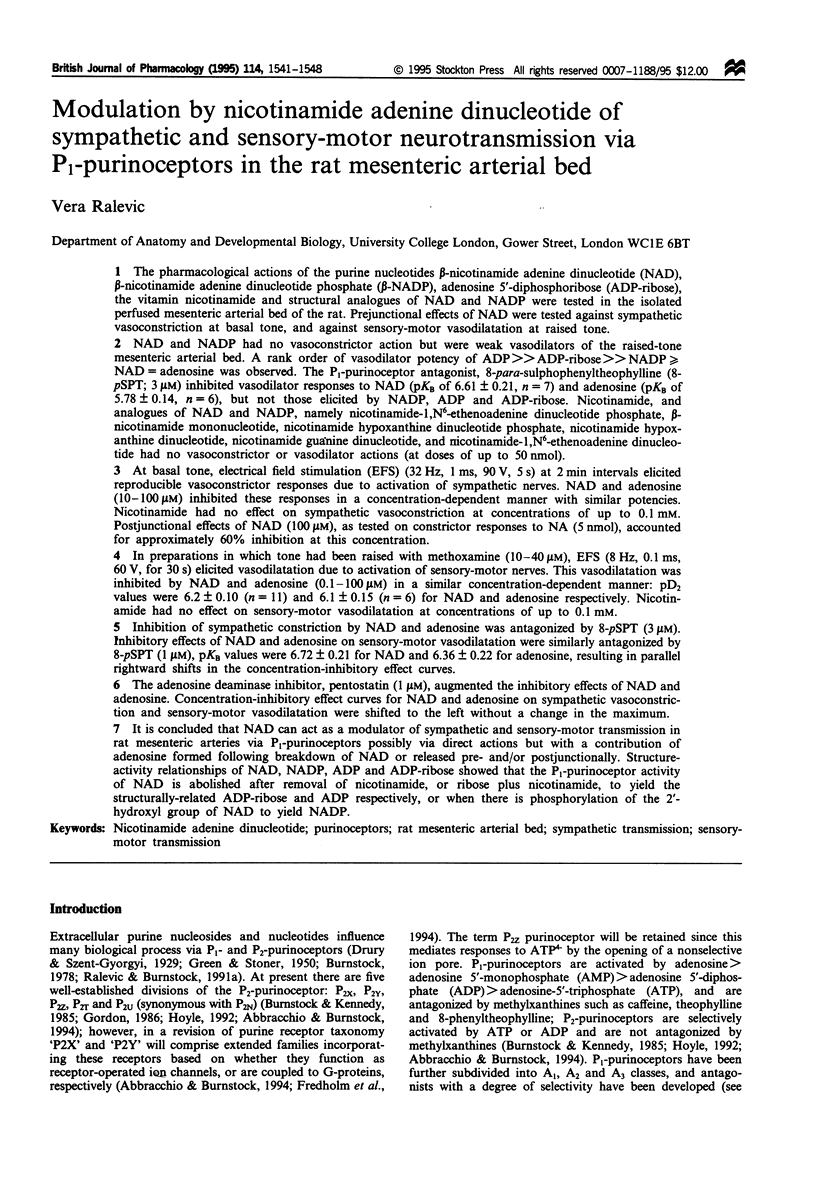
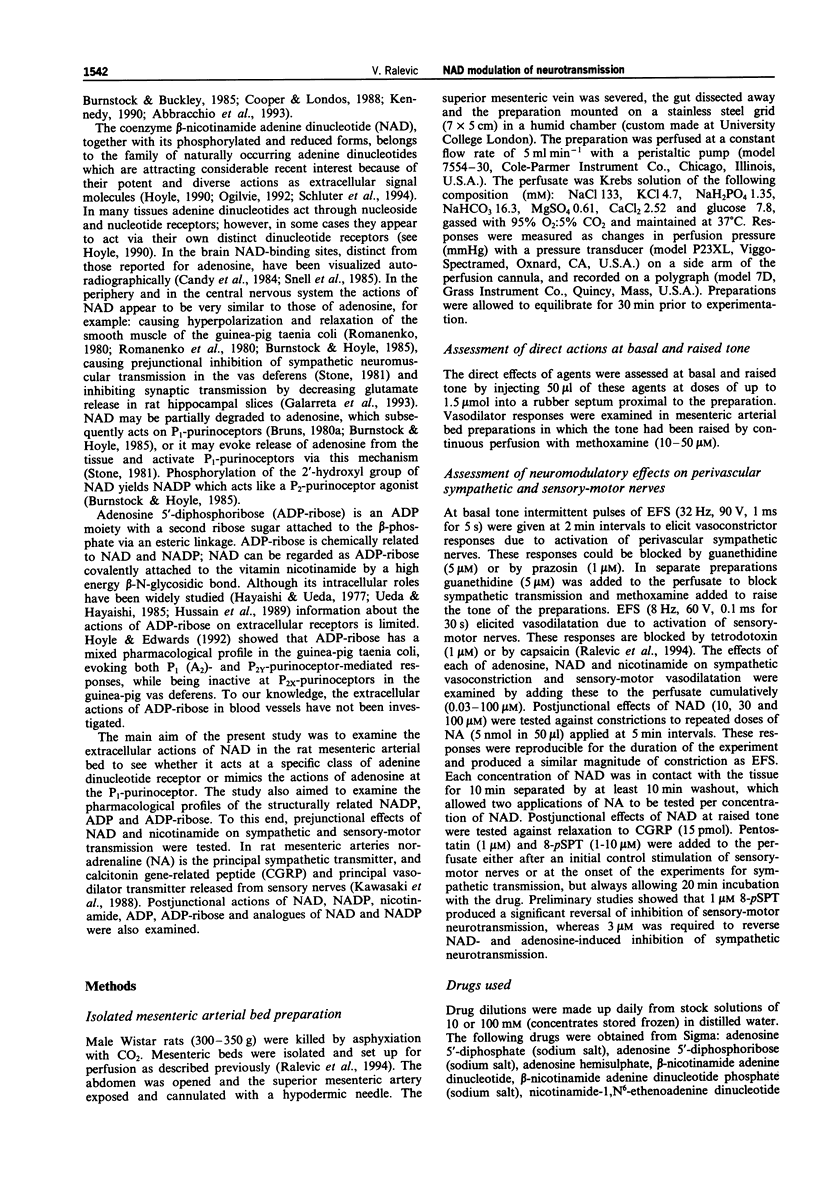
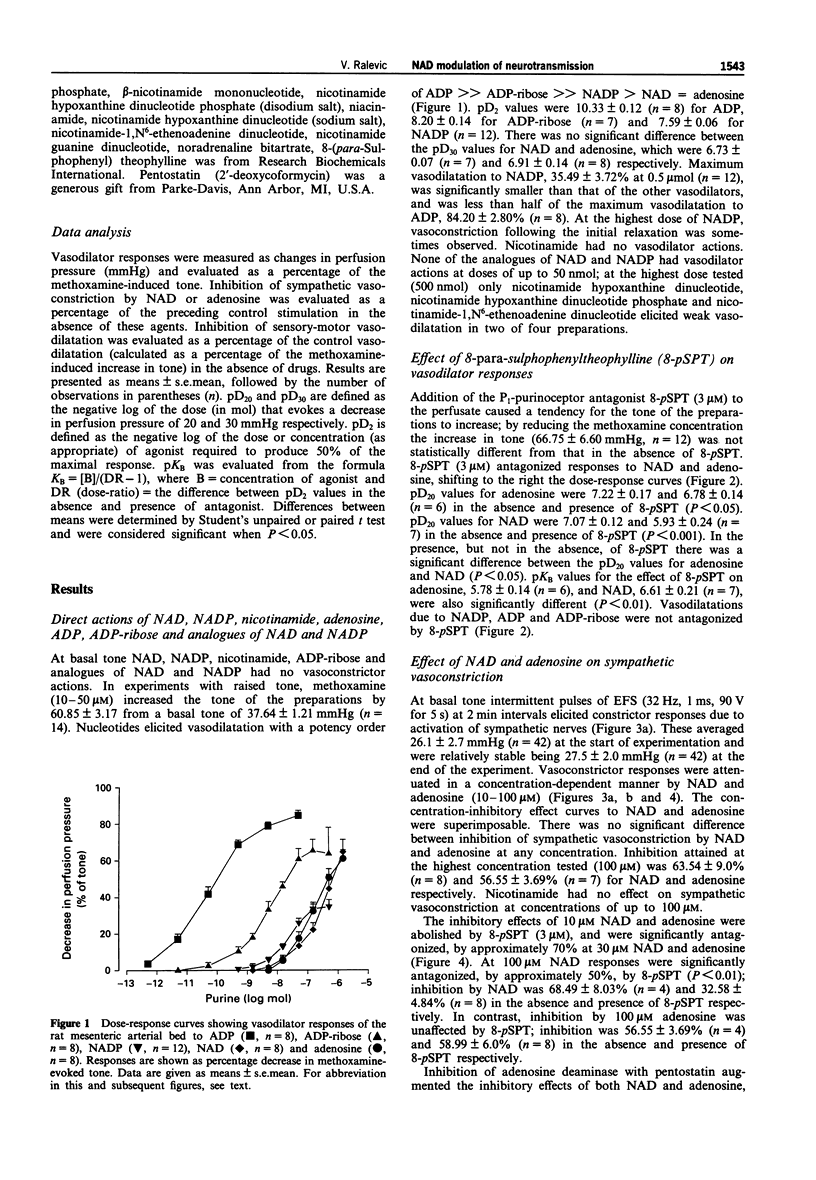
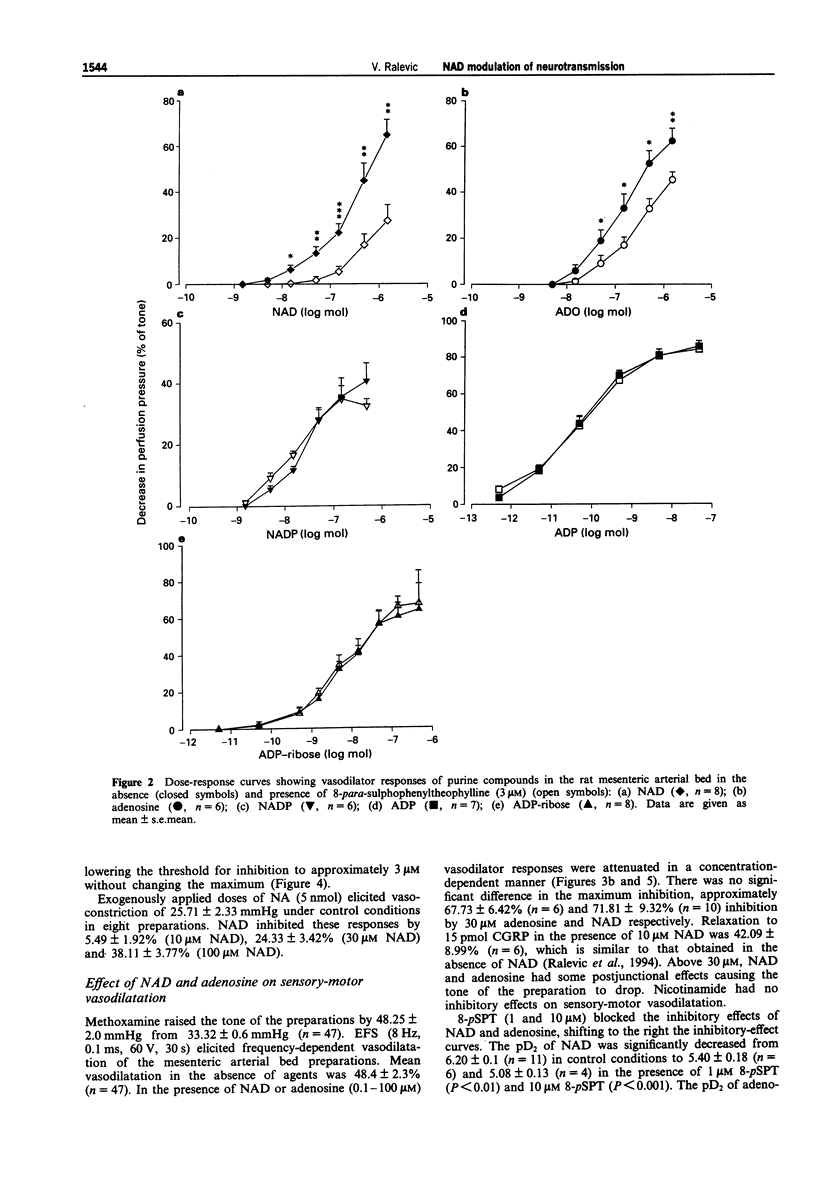
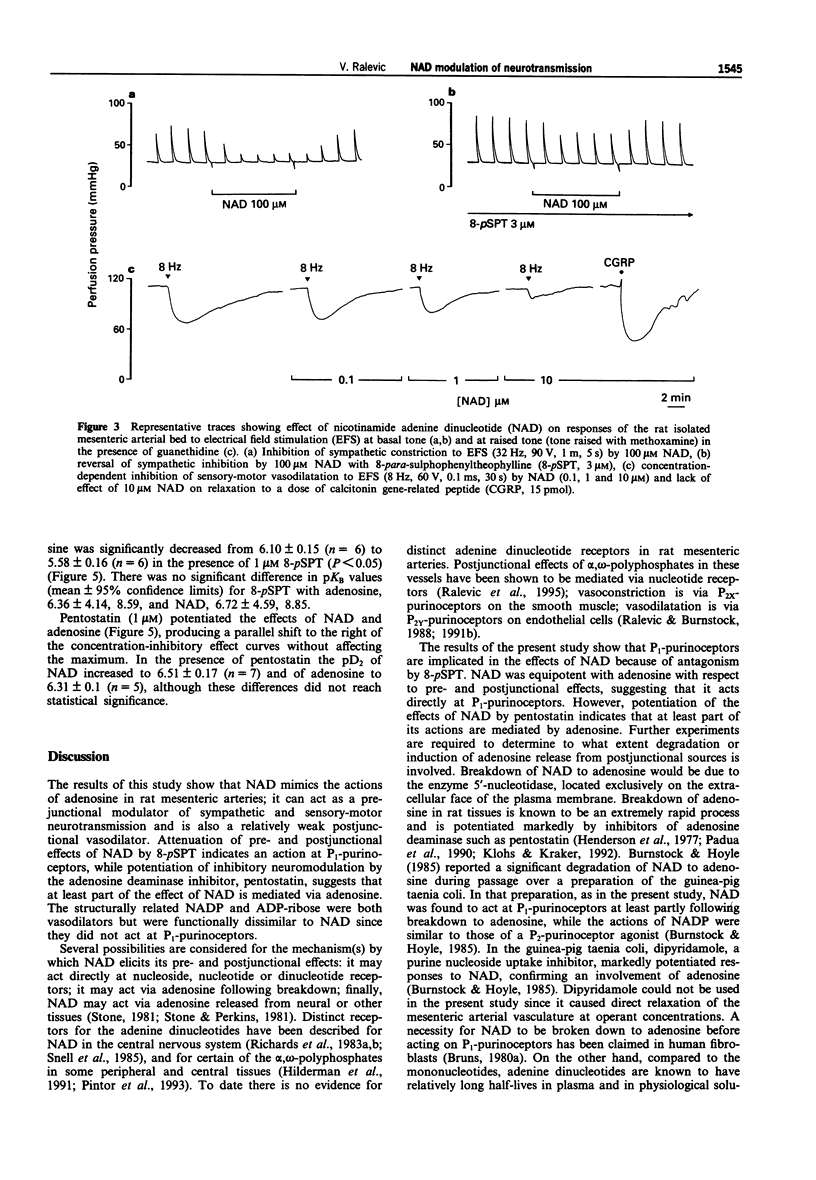
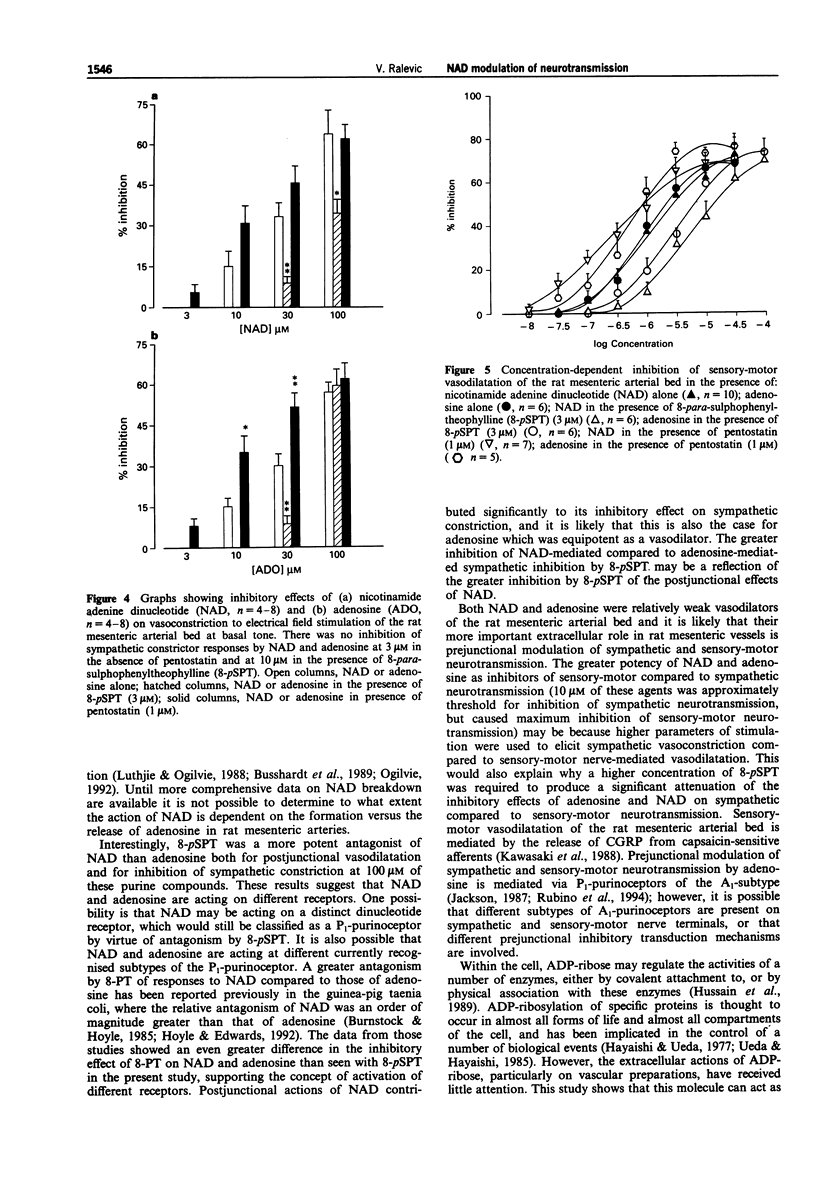
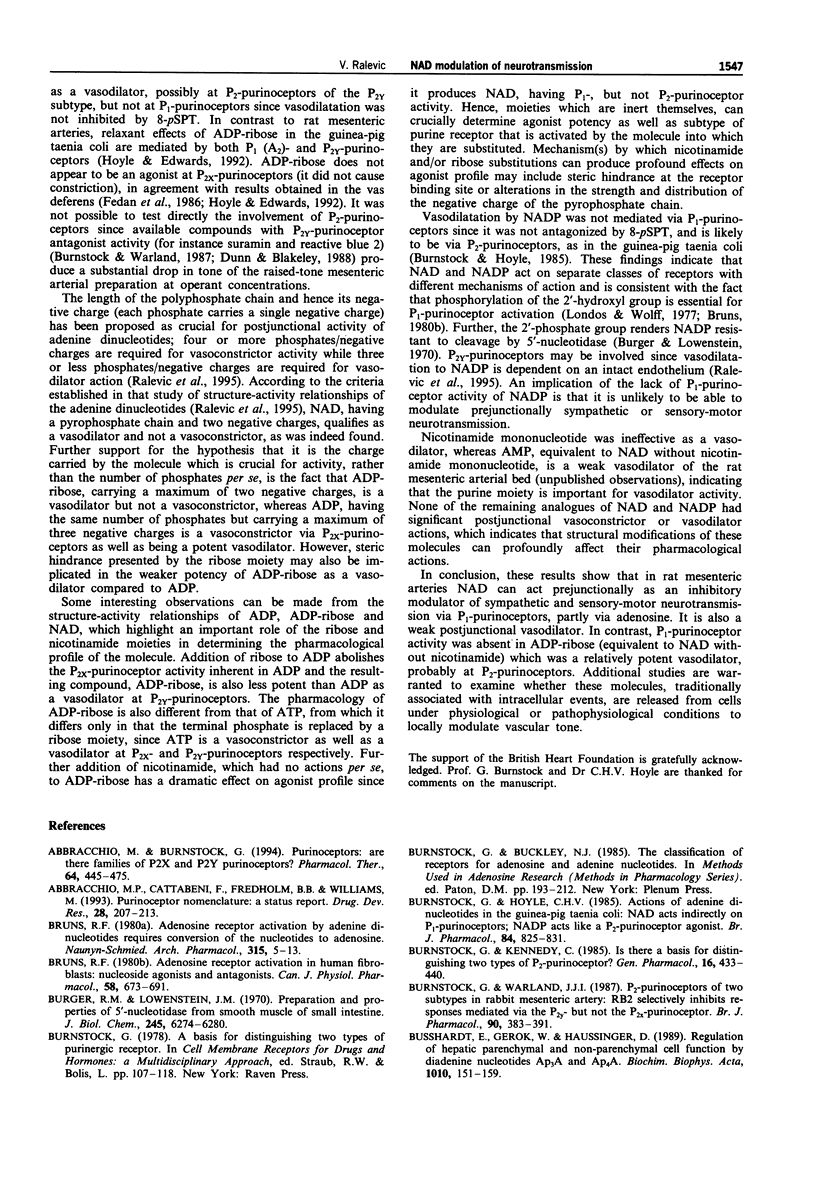
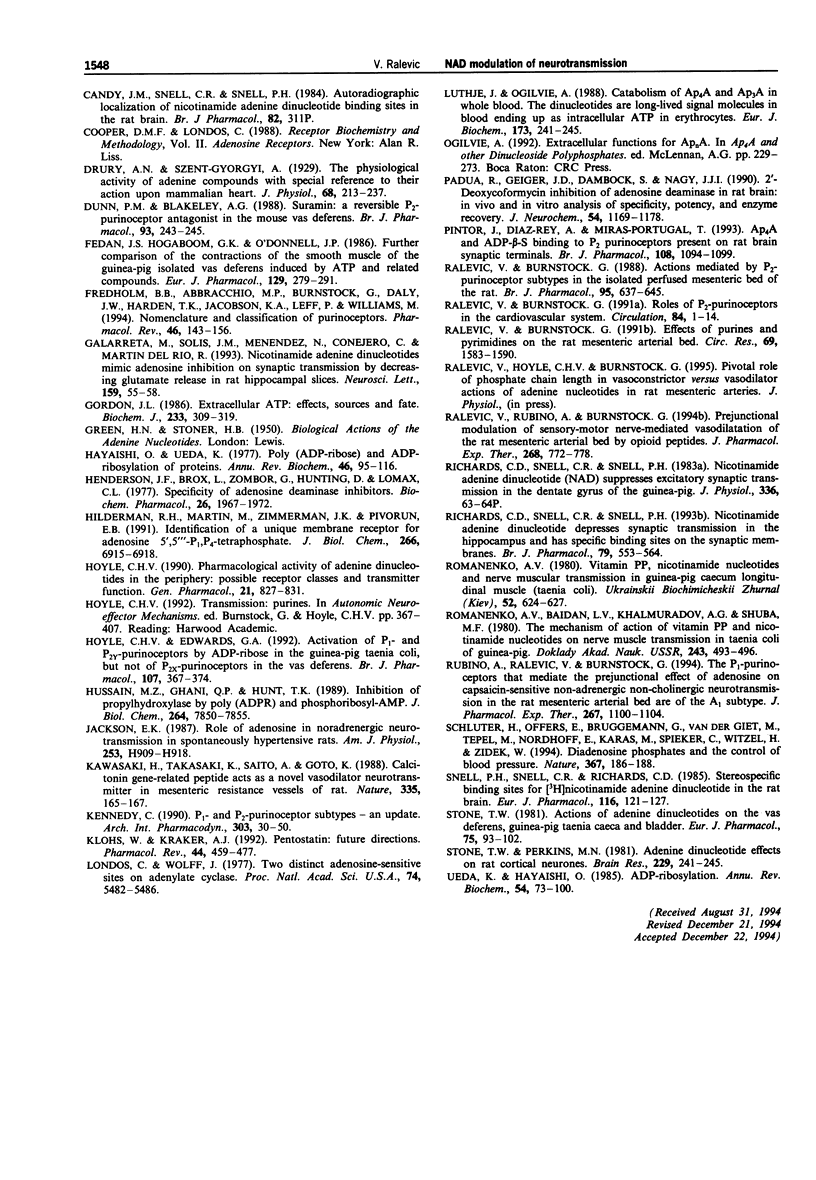
Selected References
These references are in PubMed. This may not be the complete list of references from this article.
- Abbracchio M. P., Burnstock G. Purinoceptors: are there families of P2X and P2Y purinoceptors? Pharmacol Ther. 1994;64(3):445–475. doi: 10.1016/0163-7258(94)00048-4. [DOI] [PubMed] [Google Scholar]
- Bruns R. F. Adenosine receptor activation by adenine nucleotides requires conversion of the nucleotides to adenosine. Naunyn Schmiedebergs Arch Pharmacol. 1980;315(1):5–13. doi: 10.1007/BF00504224. [DOI] [PubMed] [Google Scholar]
- Bruns R. F. Adenosine receptor activation in human fibroblasts: nucleoside agonists and antagonists. Can J Physiol Pharmacol. 1980 Jun;58(6):673–691. doi: 10.1139/y80-110. [DOI] [PubMed] [Google Scholar]
- Burger R. M., Lowenstein J. M. Preparation and properties of 5'-nucleotidase from smooth muscle of small intestine. J Biol Chem. 1970 Dec 10;245(23):6274–6280. [PubMed] [Google Scholar]
- Burnstock G., Hoyle C. H. Actions of adenine dinucleotides in the guinea-pig taenia coli: NAD acts indirectly on P1-purinoceptors; NADP acts like a P2-purinoceptor agonist. Br J Pharmacol. 1985 Apr;84(4):825–831. doi: 10.1111/j.1476-5381.1985.tb17376.x. [DOI] [PMC free article] [PubMed] [Google Scholar]
- Burnstock G., Kennedy C. Is there a basis for distinguishing two types of P2-purinoceptor? Gen Pharmacol. 1985;16(5):433–440. doi: 10.1016/0306-3623(85)90001-1. [DOI] [PubMed] [Google Scholar]
- Burnstock G., Warland J. J. P2-purinoceptors of two subtypes in the rabbit mesenteric artery: reactive blue 2 selectively inhibits responses mediated via the P2y-but not the P2x-purinoceptor. Br J Pharmacol. 1987 Feb;90(2):383–391. doi: 10.1111/j.1476-5381.1987.tb08968.x. [DOI] [PMC free article] [PubMed] [Google Scholar]
- Busshardt E., Gerok W., Häussinger D. Regulation of hepatic parenchymal and non-parenchymal cell function by the diadenine nucleotides Ap3A and Ap4A. Biochim Biophys Acta. 1989 Feb 9;1010(2):151–159. doi: 10.1016/0167-4889(89)90155-9. [DOI] [PubMed] [Google Scholar]
- Drury A. N., Szent-Györgyi A. The physiological activity of adenine compounds with especial reference to their action upon the mammalian heart. J Physiol. 1929 Nov 25;68(3):213–237. doi: 10.1113/jphysiol.1929.sp002608. [DOI] [PMC free article] [PubMed] [Google Scholar]
- Dunn P. M., Blakeley A. G. Suramin: a reversible P2-purinoceptor antagonist in the mouse vas deferens. Br J Pharmacol. 1988 Feb;93(2):243–245. doi: 10.1111/j.1476-5381.1988.tb11427.x. [DOI] [PMC free article] [PubMed] [Google Scholar]
- Fedan J. S., Hogaboom G. K., O'Donnell J. P. Further comparison of contractions of the smooth muscle of the guinea-pig isolated vas deferens induced by ATP and related analogs. Eur J Pharmacol. 1986 Oct 7;129(3):279–291. doi: 10.1016/0014-2999(86)90438-3. [DOI] [PubMed] [Google Scholar]
- Fredholm B. B., Abbracchio M. P., Burnstock G., Daly J. W., Harden T. K., Jacobson K. A., Leff P., Williams M. Nomenclature and classification of purinoceptors. Pharmacol Rev. 1994 Jun;46(2):143–156. [PMC free article] [PubMed] [Google Scholar]
- Galarreta M., Solís J. M., Menéndez N., Conejero C., Martín del Río R. Nicotinamide adenine dinucleotides mimic adenosine inhibition on synaptic transmission by decreasing glutamate release in rat hippocampal slices. Neurosci Lett. 1993 Sep 3;159(1-2):55–58. doi: 10.1016/0304-3940(93)90797-o. [DOI] [PubMed] [Google Scholar]
- Gordon J. L. Extracellular ATP: effects, sources and fate. Biochem J. 1986 Jan 15;233(2):309–319. doi: 10.1042/bj2330309. [DOI] [PMC free article] [PubMed] [Google Scholar]
- Hayaishi O., Ueda K. Poly(ADP-ribose) and ADP-ribosylation of proteins. Annu Rev Biochem. 1977;46:95–116. doi: 10.1146/annurev.bi.46.070177.000523. [DOI] [PubMed] [Google Scholar]
- Henderson J. F., Brox L., Zombor G., Hunting D., Lomax C. A. Specificity of adenosine deaminase inhibitors. Biochem Pharmacol. 1977 Nov 1;26(21):1967–1972. doi: 10.1016/0006-2952(77)90003-x. [DOI] [PubMed] [Google Scholar]
- Hilderman R. H., Martin M., Zimmerman J. K., Pivorun E. B. Identification of a unique membrane receptor for adenosine 5',5"'-P1,P4-tetraphosphate. J Biol Chem. 1991 Apr 15;266(11):6915–6918. [PubMed] [Google Scholar]
- Hoyle C. H., Edwards G. A. Activation of P1- and P2Y-purinoceptors by ADP-ribose in the guinea-pig taenia coli, but not of P2X-purinoceptors in the vas deferens. Br J Pharmacol. 1992 Oct;107(2):367–374. doi: 10.1111/j.1476-5381.1992.tb12753.x. [DOI] [PMC free article] [PubMed] [Google Scholar]
- Hoyle C. H. Pharmacological activity of adenine dinucleotides in the periphery: possible receptor classes and transmitter function. Gen Pharmacol. 1990;21(6):827–831. doi: 10.1016/0306-3623(90)90440-w. [DOI] [PubMed] [Google Scholar]
- Hussain M. Z., Ghani Q. P., Hunt T. K. Inhibition of prolyl hydroxylase by poly(ADP-ribose) and phosphoribosyl-AMP. Possible role of ADP-ribosylation in intracellular prolyl hydroxylase regulation. J Biol Chem. 1989 May 15;264(14):7850–7855. [PubMed] [Google Scholar]
- Jackson E. K. Role of adenosine in noradrenergic neurotransmission in spontaneously hypertensive rats. Am J Physiol. 1987 Oct;253(4 Pt 2):H909–H918. doi: 10.1152/ajpheart.1987.253.4.H909. [DOI] [PubMed] [Google Scholar]
- Kawasaki H., Takasaki K., Saito A., Goto K. Calcitonin gene-related peptide acts as a novel vasodilator neurotransmitter in mesenteric resistance vessels of the rat. Nature. 1988 Sep 8;335(6186):164–167. doi: 10.1038/335164a0. [DOI] [PubMed] [Google Scholar]
- Kennedy C. P1- and P2-purinoceptor subtypes--an update. Arch Int Pharmacodyn Ther. 1990 Jan-Feb;303:30–50. [PubMed] [Google Scholar]
- Klohs W. D., Kraker A. J. Pentostatin: future directions. Pharmacol Rev. 1992 Dec;44(4):459–477. [PubMed] [Google Scholar]
- Londos C., Wolff J. Two distinct adenosine-sensitive sites on adenylate cyclase. Proc Natl Acad Sci U S A. 1977 Dec;74(12):5482–5486. doi: 10.1073/pnas.74.12.5482. [DOI] [PMC free article] [PubMed] [Google Scholar]
- Lüthje J., Ogilvie A. Catabolism of Ap4A and Ap3A in whole blood. The dinucleotides are long-lived signal molecules in the blood ending up as intracellular ATP in the erythrocytes. Eur J Biochem. 1988 Apr 5;173(1):241–245. doi: 10.1111/j.1432-1033.1988.tb13990.x. [DOI] [PubMed] [Google Scholar]
- Padua R., Geiger J. D., Dambock S., Nagy J. I. 2'-Deoxycoformycin inhibition of adenosine deaminase in rat brain: in vivo and in vitro analysis of specificity, potency, and enzyme recovery. J Neurochem. 1990 Apr;54(4):1169–1178. doi: 10.1111/j.1471-4159.1990.tb01945.x. [DOI] [PubMed] [Google Scholar]
- Pintor J., Díaz-Rey M. A., Miras-Portugal M. T. Ap4A and ADP-beta-S binding to P2 purinoceptors present on rat brain synaptic terminals. Br J Pharmacol. 1993 Apr;108(4):1094–1099. doi: 10.1111/j.1476-5381.1993.tb13510.x. [DOI] [PMC free article] [PubMed] [Google Scholar]
- Ralevic V., Burnstock G. Actions mediated by P2-purinoceptor subtypes in the isolated perfused mesenteric bed of the rat. Br J Pharmacol. 1988 Oct;95(2):637–645. doi: 10.1111/j.1476-5381.1988.tb11686.x. [DOI] [PMC free article] [PubMed] [Google Scholar]
- Ralevic V., Burnstock G. Effects of purines and pyrimidines on the rat mesenteric arterial bed. Circ Res. 1991 Dec;69(6):1583–1590. doi: 10.1161/01.res.69.6.1583. [DOI] [PubMed] [Google Scholar]
- Ralevic V., Burnstock G. Roles of P2-purinoceptors in the cardiovascular system. Circulation. 1991 Jul;84(1):1–14. doi: 10.1161/01.cir.84.1.1. [DOI] [PubMed] [Google Scholar]
- Ralevic V., Rubino A., Burnstock G. Prejunctional modulation of sensory-motor nerve-mediated vasodilatation of the rat mesenteric arterial bed by opioid peptides. J Pharmacol Exp Ther. 1994 Feb;268(2):772–778. [PubMed] [Google Scholar]
- Richards C. D., Snell C. R., Snell P. H. Nicotinamide adenine dinucleotide depresses synaptic transmission in the hippocampus and has specific binding sites on the synaptic membranes. Br J Pharmacol. 1983 Jun;79(2):553–564. doi: 10.1111/j.1476-5381.1983.tb11030.x. [DOI] [PMC free article] [PubMed] [Google Scholar]
- Romanenko A. V., Baidan L. V., Khalmuradov A. G., Shuba M. F. Mekhanizm deistviia vitamina PP i nikotinamidnykh nukleotidov na nervno-myshechnuiu peredachu v taenia coli morskoi svinki. Dokl Akad Nauk SSSR. 1980;255(2):493–496. [PubMed] [Google Scholar]
- Romanenko A. V. Vitamin PP, nikotinamidnye nikleotidy i nirvno-myshechnaia peredacha v prodol noí myshtse slepoí kitski (TAENIA COLI) morskoí svinki. Taenia (coli). Ukr Biokhim Zh (1978) 1980 Sep-Oct;52(5):624–627. [PubMed] [Google Scholar]
- Rubino A., Ralevic V., Burnstock G. The P1-purinoceptors that mediate the prejunctional inhibitory effect of adenosine on capsaicin-sensitive nonadrenergic noncholinergic neurotransmission in the rat mesenteric arterial bed are of the A1 subtype. J Pharmacol Exp Ther. 1993 Dec;267(3):1100–1104. [PubMed] [Google Scholar]
- Schlüter H., Offers E., Brüggemann G., van der Giet M., Tepel M., Nordhoff E., Karas M., Spieker C., Witzel H., Zidek W. Diadenosine phosphates and the physiological control of blood pressure. Nature. 1994 Jan 13;367(6459):186–188. doi: 10.1038/367186a0. [DOI] [PubMed] [Google Scholar]
- Snell P. H., Snell C. R., Richards C. D. Stereospecific binding sites for [3H]nicotinamide adenine dinucleotide in the rat brain. Eur J Pharmacol. 1985 Oct 8;116(1-2):121–127. doi: 10.1016/0014-2999(85)90192-x. [DOI] [PubMed] [Google Scholar]
- Stone T. W. Actions of adenine dinucleotides on the vas deferens, guinea-pig taenia caeci and bladder. Eur J Pharmacol. 1981 Oct 22;75(2-3):93–102. doi: 10.1016/0014-2999(81)90066-2. [DOI] [PubMed] [Google Scholar]
- Stone T. W., Perkins M. N. Adenine dinucleotide effects on rat cortical neurones. Brain Res. 1981 Dec 14;229(1):241–245. doi: 10.1016/0006-8993(81)90764-2. [DOI] [PubMed] [Google Scholar]
- Ueda K., Hayaishi O. ADP-ribosylation. Annu Rev Biochem. 1985;54:73–100. doi: 10.1146/annurev.bi.54.070185.000445. [DOI] [PubMed] [Google Scholar]


